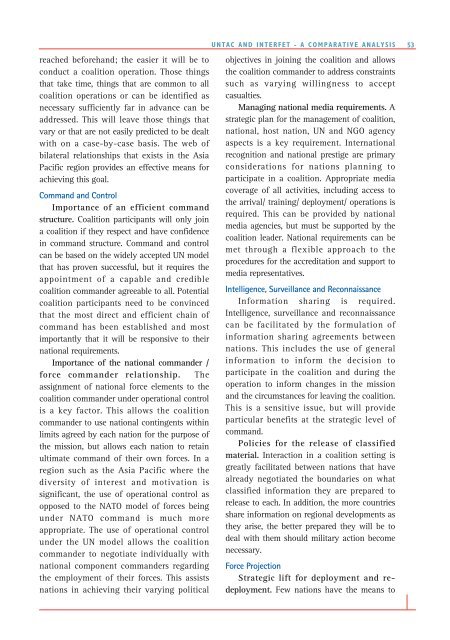ISSUE 150 : Sep/Oct - 2001 - Australian Defence Force Journal
ISSUE 150 : Sep/Oct - 2001 - Australian Defence Force Journal
ISSUE 150 : Sep/Oct - 2001 - Australian Defence Force Journal
You also want an ePaper? Increase the reach of your titles
YUMPU automatically turns print PDFs into web optimized ePapers that Google loves.
eached beforehand; the easier it will be toconduct a coalition operation. Those thingsthat take time, things that are common to allcoalition operations or can be identified asnecessary sufficiently far in advance can beaddressed. This will leave those things thatvary or that are not easily predicted to be dealtwith on a case-by-case basis. The web ofbilateral relationships that exists in the AsiaPacific region provides an effective means forachieving this goal.Command and ControlImportance of an efficient commandstructure. Coalition participants will only joina coalition if they respect and have confidencein command structure. Command and controlcan be based on the widely accepted UN modelthat has proven successful, but it requires theappointment of a capable and crediblecoalition commander agreeable to all. Potentialcoalition participants need to be convincedthat the most direct and efficient chain ofcommand has been established and mostimportantly that it will be responsive to theirnational requirements.Importance of the national commander /force commander relationship. Theassignment of national force elements to thecoalition commander under operational controlis a key factor. This allows the coalitioncommander to use national contingents withinlimits agreed by each nation for the purpose ofthe mission, but allows each nation to retainultimate command of their own forces. In aregion such as the Asia Pacific where thediversity of interest and motivation issignificant, the use of operational control asopposed to the NATO model of forces beingunder NATO command is much moreappropriate. The use of operational controlunder the UN model allows the coalitioncommander to negotiate individually withnational component commanders regardingthe employment of their forces. This assistsnations in achieving their varying politicalUNTAC AND INTERFET - A COMPARATIVE ANALYSISobjectives in joining the coalition and allowsthe coalition commander to address constraintssuch as varying willingness to acceptcasualties.Managing national media requirements. Astrategic plan for the management of coalition,national, host nation, UN and NGO agencyaspects is a key requirement. Internationalrecognition and national prestige are primaryconsiderations for nations planning toparticipate in a coalition. Appropriate mediacoverage of all activities, including access tothe arrival/ training/ deployment/ operations isrequired. This can be provided by nationalmedia agencies, but must be supported by thecoalition leader. National requirements can bemet through a flexible approach to theprocedures for the accreditation and support tomedia representatives.Intelligence, Surveillance and ReconnaissanceInformation sharing is required.Intelligence, surveillance and reconnaissancecan be facilitated by the formulation ofinformation sharing agreements betweennations. This includes the use of generalinformation to inform the decision toparticipate in the coalition and during theoperation to inform changes in the missionand the circumstances for leaving the coalition.This is a sensitive issue, but will provideparticular benefits at the strategic level ofcommand.Policies for the release of classifiedmaterial. Interaction in a coalition setting isgreatly facilitated between nations that havealready negotiated the boundaries on whatclassified information they are prepared torelease to each. In addition, the more countriesshare information on regional developments asthey arise, the better prepared they will be todeal with them should military action becomenecessary.<strong>Force</strong> ProjectionStrategic lift for deployment and redeployment.Few nations have the means to53
















